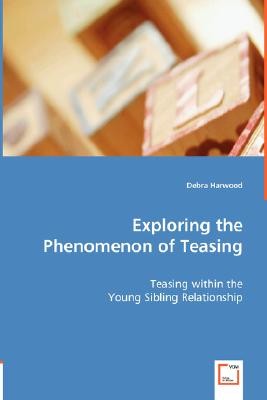
- We will send in 10–14 business days.
- Author: Debra Harwood
- Publisher: VDM Verlag Dr. Mueller E.K.
- Year: 2008
- Pages: 392
- ISBN-10: 3836489309
- ISBN-13: 9783836489300
- Format: 15.2 x 22.9 x 2.1 cm, softcover
- Language: English
- SAVE -10% with code: EXTRA
Reviews
Description
Teasing is often regarded as a normal and common activity of child-hood, a rite of passage. Yet, teasing is a complex relational issue involving many elements such as intent, verbal utterances, nonverbal behaviour, meaning, interpretation, and emotional affect. And despite the prevalence of this common childhood experience, research addressing children's teasing is lacking. Studies of how young children experience, resist, and internalize childhood teasing in various contexts are noticeably absent from the research literature. The young sibling bond provides a unique window of opportunity to explore the teasing phenomenon, as this intense, complex, and emotional relationship is an early practice ground for children to learn to inter-act, imitate, play, converse, and negotiate conflict. This book discusses a study that explored, through naturalistic obser-vations and interviews, the teasing experiences of three dyads of preschool age siblings.
EXTRA 10 % discount with code: EXTRA
The promotion ends in 19d.17:26:46
The discount code is valid when purchasing from 10 €. Discounts do not stack.
- Author: Debra Harwood
- Publisher: VDM Verlag Dr. Mueller E.K.
- Year: 2008
- Pages: 392
- ISBN-10: 3836489309
- ISBN-13: 9783836489300
- Format: 15.2 x 22.9 x 2.1 cm, softcover
- Language: English English
Teasing is often regarded as a normal and common activity of child-hood, a rite of passage. Yet, teasing is a complex relational issue involving many elements such as intent, verbal utterances, nonverbal behaviour, meaning, interpretation, and emotional affect. And despite the prevalence of this common childhood experience, research addressing children's teasing is lacking. Studies of how young children experience, resist, and internalize childhood teasing in various contexts are noticeably absent from the research literature. The young sibling bond provides a unique window of opportunity to explore the teasing phenomenon, as this intense, complex, and emotional relationship is an early practice ground for children to learn to inter-act, imitate, play, converse, and negotiate conflict. This book discusses a study that explored, through naturalistic obser-vations and interviews, the teasing experiences of three dyads of preschool age siblings.


Reviews